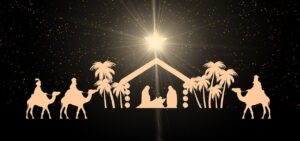We all love the Christmas story in Matthew’s gospel. Mary and Joseph are pledged to be married. An angel appears to her. When Joseph finds out she’s already pregnant, he decides to divorce her quietly. But an angel tells him no. Her son will be the savior. After Jesus is born in Bethlehem, the Magi bring their gifts. Joseph then takes his family to Egypt to avoid Herod’s threats (Matthew 1:18 –2:18).
 What we seldom notice, however, is that there is another Christmas story in Matthew, another version of how Jesus was born to Mary and Joseph. This overlooked account is squeezed between a list of Jesus’ ancestors and the familiar story. Here it is:
What we seldom notice, however, is that there is another Christmas story in Matthew, another version of how Jesus was born to Mary and Joseph. This overlooked account is squeezed between a list of Jesus’ ancestors and the familiar story. Here it is:
And Jacob [was] the father of Joseph, the husband of Mary, and Mary was the mother of Jesus who is called the Messiah. (Matthew 1:16)
The first seventeen verse of Matthew contain a genealogy of Jesus, tracing his roots from Abraham to David, then through the exile in Babylon, culminating in Jesus. In verse 17 Matthew emphasizes these four touch points in Israel’s story.*
♦ The promises to Israel of land, of being a great nation, and of blessing all nations (Abraham)
♦ Israel’s royal history (David)
♦ Israel’s failure to keep the covenant (exile in Babylon)
♦ The culmination of Israel’s history (Jesus)
All the promises to Abraham and all the restoration Israel needs for her sins, Matthew is saying, are fulfilled in Jesus, Israel’s royal son of David.
 Matthew’s grand, sweeping overview before the intimate portrait of Mary and Joseph is like a movie that begins with the whole universe in view. Then the camera moves faster than the speed of light through billions of galaxies to pause momentarily on the Milky Way before finding our solar system, racing past Saturn and Jupiter to Earth, then the Middle East, and zeroing in on a room in a Palestinian hovel.
Matthew’s grand, sweeping overview before the intimate portrait of Mary and Joseph is like a movie that begins with the whole universe in view. Then the camera moves faster than the speed of light through billions of galaxies to pause momentarily on the Milky Way before finding our solar system, racing past Saturn and Jupiter to Earth, then the Middle East, and zeroing in on a room in a Palestinian hovel.
Yes, in those first 17 verses Matthew is saying, Jesus came to save us as individuals, but he also came to fulfill God’s entire plan for Israel and all creation through King Jesus.
We should notice at least one other important feature of Matthew’s list. Remarkably for a patriarchal culture, he lists four women—Tamar, Rahab, Ruth, and Mary. Why are they included? What they have in common is a clue.
To begin, the first three are gentiles. God promised to Abraham in Genesis 12 that Israel would be a blessing to all nations, a role it often forgot. Jesus’ own genealogy (yes, his genes) already showed how all those outside Israel were also included in the promise.
Second, while all four women had suspect sexual backgrounds, that is not Matthew’s emphasis. They are all honored for their fidelity to the line of the Messiah. Each of these women played a critical role when the line of promise was threatened.
Tamar rescued Judah’s line from ending (Genesis 38:1-30). Rahab protected Israel’s spies in Jericho, preserving Israel so it could enter the land God promised Abraham (Joshua 2:1-21). Ruth’s deceased husband was from the line of Judah; by her faithful tenacity, she found a new husband from that tribe and became the great grandmother of David (Ruth 1-4, especially 4:16-22). As Chris Bruno and others said,
These three Gentile women are not only the ancestors of the Messiah, but also point forward to him in their work of preserving God’s covenant line and rescuing his people from imminent destruction. In other words, they are themselves saviours of Israel. (p. 21)
The familiar Christmas story offers so much to love. Through Matthew’s other story of Christmas, we have even more.
—
*Chris Bruno, Jared Compton, and Kevin McFadden, Biblical Theology According to the Apostles, NSBT (Downers Grove, IL: IVP Academic, 2020), pp. 11-22.
Nativity image by Gerd Altmann from Pixabay

Thanks for this reminder!